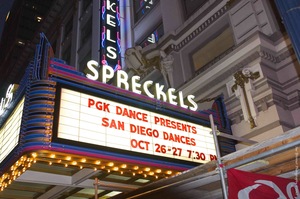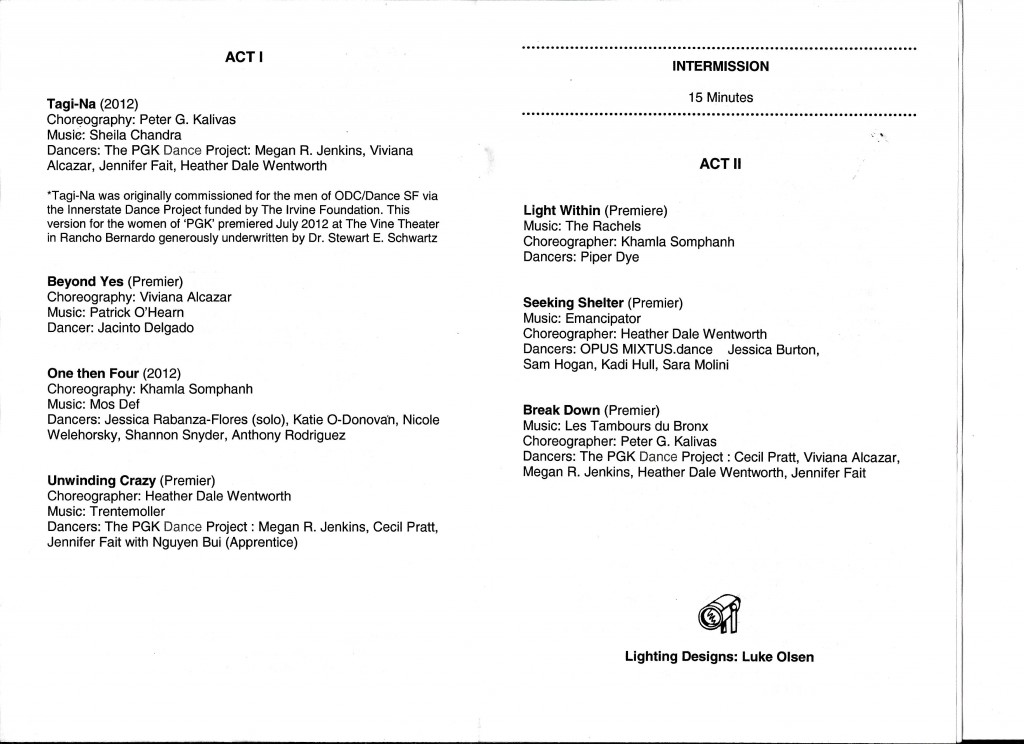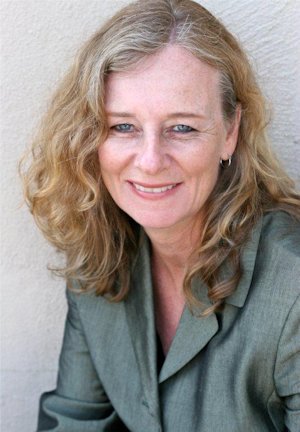‘San Diego Dances on Broadway’ cut loose in the lobby

“San Diego Dances” is a bi-annual series created through partnerships that make dance more affordable and available. Photo courtesy of The PGK Project.
Intrepid dance troupes are performing in non-traditional settings all over town. One of the most ambitious, and thrifty, is The PGK Project, directed by Peter G. Kalivas (pronounced Kah-LEE-vahs).
Kalivas’ roving dance series “San Diego Dances” started in a hair salon in Hillcrest, bounced to a rec center in Golden Hill, then a wine bar, and sports center. Kalivas is not orchestrating site-specific works; rather his aim is to grow an audience without having to pay for performance space.
The most recent iteration, called “San Diego Dances on Broadway,” drew crowds to the stately Spreckels Theatre lobby. Smooth onyx walls and intricate tiles provided a spare backdrop for seven short and lively dances.
Highlights included two works by Khamla Somphanh that reminded viewers of her choreographic range.
The ensemble work “One then Four” kicked off with a mini-solo (Jessica Rabanza-Flores) and four remaining in slinky syncopation, all set to Mos Def.
Women hunched over and rocked on the balls of their feet. The men, Shannon Snyder and Anthony Rodriguez, moved effortlessly over the hard floor, like cats in tuxedo pants. (Snyder was also excellent in Trolley Dances earlier this month. The last time I’d seen Rodriguez on stage was when he won the San Diego Young Choreographer’s Showcase in 2010).
Strong technique was also on display in Somphanh’s “Light Within,” a solo for Piper Dye.
Dye, who hails from San Diego School of Creative and Performing Arts, has danced at Stage 7 and Eveoke. That rich background shines through in Somphanh’s tightly bound vocabulary. A thrilling sequence had Dye slowly open her gripped hands with fingers splayed, and wham – she kicked her leg out. Those little collisions sent tingles up my arms.
Viviana Alcazar’s “Beyond Yes,” a solo that focused on the struggles of men, seemed designed for the space. Dressed in pedestrian clothes, a frantic Patrick O’Hearn shared his inner pain and tried to flick it off.
Giant glass doors separated him from the rest of the world. Strangers on the sidewalk glanced and kept walking. A bus and cars roared by. It all came together and made him appear even more lonely and unimportant.
Heather Dale Wentworth presented two works, both premieres. “Unwinding Crazy,” though well turned out, was set to a sleep inducing score, sort of a techno lullaby. Complex footwork and some nice partnering were engaging but the structure was odd. “Seeking Shelter” was set to a more energized electronic score. If only the score offered clues to a guiding idea. The work offered little in terms of imagery, narrative, or emotional depth. Four emerging dancers gave it their all, but needed more direction.
Kalivas opened and closed the program with athletic dances, both well-crafted and beautifully danced.
“Tagi-Na” was originally commissioned for men in Orange County. A version for women of The PGK Project premiered at The Vine this summer, and they brought it downtown. Set to music by Sheila Chandra, the women appeared as an ancient tribe. Without fear, they rippled their bodies and rolled over the floor, pushing their hands into the floor to rebound back to a standing position.
The closing dance, “Break Down,” allowed PGK dancers to cut loose in a normally subdued setting. Hip swivels and spins in penché (bent at the waist) with heads down had to be controlled in the long narrow space. Cecil Pratt was excellent in leaps with nice turned out feet. Unison was sharp. Viewers left feeling upbeat.
Kalivas knows how to produce a fast-moving program without curtains, sets, or stages. Sure, there are tradeoffs in presenting dance in odd places – hmm, shall I experience dance at the Balboa or the beauty salon? Some people will never go for this model. Those white folding chairs are uncomfortable. Still, there is much to be gained by losing the stage. Move the rows up about 15 feet. Suddenly everyone has an intimate view. Patterns in the dances become more obvious. Leaps and lifts appear more difficult, risky, because they are. And we’ll never look at the lonely Spreckels lobby the same way.


Kris Eitland covers dance and theater for Sandiegostory.com and freelances for other publications, including the Union Tribune and Dance Teacher Magazine. She grew up performing many dance styles and continued intensive modern dance and choreography at the Univ. of Minnesota, Duluth, and San Diego State Univ. She also holds a journalism degree from SDSU. Her career includes stints in commercial and public radio news production.
Eitland has won numerous Excellence in Journalism awards for criticism and reporting from the San Diego Press Club. She has served on the Press Club board since 2011 and is a past president. She is a co-founder of Sandiegostory.com. She has a passion for the arts, throwing parties with dancing and singing, and cruising the Pacific in her family’s vintage trawler. She trains dogs, skis, and loves seasonal trips to her home state of Minnesota.
